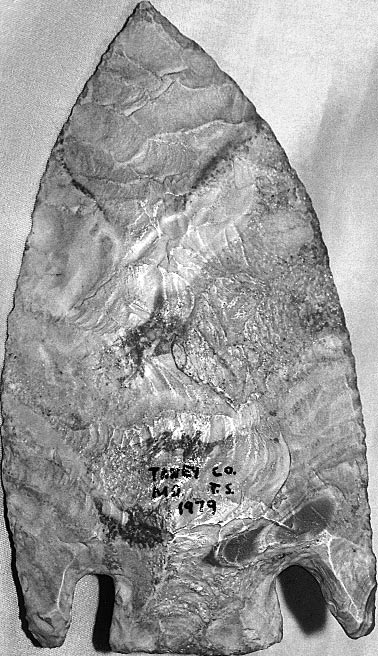|
A Smith Finds a Smith
|
Tim Smith |
| Central States Archaeological Societies 2004
July Journal |
Gardner, Illinois |
I have hunted Indian artifacts for over fifty years in Illinois, Indiana, Missouri,
and Ohio. My work as a heavy equipment operator brought me to many locations
during the construction of bridges, highways, and other major construction sites.
I have found many Indian artifacts while at work, but this artifact was not found
at a construction site. I found it while I was turkey hunting in Taney County,
Missouri, in 1979. The turkeys just were not there; and since there was a plowed
field nearby, I decided to hunt for Indian artifacts instead and came upon a
beautiful five-inch-long Smith Basal Notch point. It is probably the finest flint
artifact I have ever found. It was crafted
from a white-cream, goldenbrown flint.
I sent a photograph to our editor, Mr. Crowley, along with a 138-word article.
John quickly responded and said that 138 words presented a layout problem. He
explained in his kind letter that it takes about 50 words to fill one inch of
typed space and that in order to publish this artifact with an article, he would
need at least 500 words. He offered to print the photograph with a caption using
my words.
I called John and explained to him that I was not a writer and asked for his
help. He graciously offered this advice, "Tim, you know where this artifact
was found. You obviously know what type point it is. You know how old it is.
Do you have any reference books? Use that information and make your article better
and more informative. Cite your books, tell us who named the point, where Smith
points were originally found. Remember, one of the goals of the Central States
Archaeological Journal is to document artifacts. Another goal is to educate our
members. With a little effort, you can make this offering an important contribution
to the journal."
Well, I got out my books, and here is what they say. The Smith Basal Notch type
was named for the Smith site in Delaware County, Oklahoma, by Baerreis and Freeman
in 1960. It is found throughout Missouri and occurs in Arkansas, Oklahoma, and
Texas and occasionally in bordering states. It dates to the Late Archaic period,
or about 3000-1000 BC. It is described as being a medium to large basal-notched
point. The blade edges are usually convex, but some may be straight. The point
has very large flake scars made by percussion. Some examples have been modified
by resharpening and can have smaller flake scars. It is usually one and one-fourth
to two times as long as it is wide. Its greatest width is at the barbs, which
may extend almost even with the sides of the base. The sides of the stem and
the base
are straight and are sometimes slightly ground.
There you have it - my first complete article for the CSAJ. I hope everyone will
enjoy my point and article. I am very proud to bring it to you and to be a part
of the finest archaeology publication there is. I would also like to thank John
Crowley, for his help, and my friend, Bruce Filbrandt, for taking the excellent
photograph.
Good luck hunting.
REFERENCES
Baerreis, D.A. and J.E. Freeman
1960 A Report on a Bluff Shelter in Northwest
Oklahoma (D1-47). Archives in Archaeology, No. 1.
Chapman, Carl H.
1975 The Archaeology of Missouri. University
of Missouri Press, Columbia, Missouri. Pg. 256.
HOME
|
|




